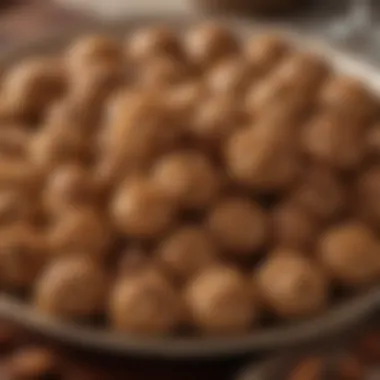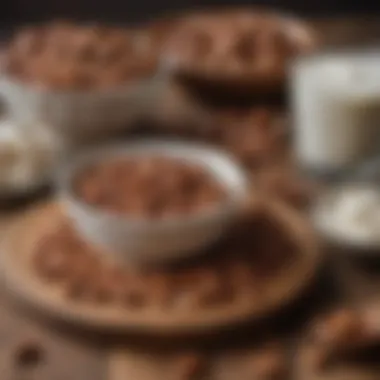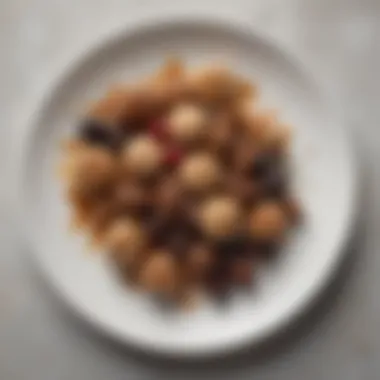Savannah Pecan Pralines: History and Culinary Techniques


Intro
Savannah pecan pralines are more than just a sweet indulgence; they embody a rich tapestry of Southern culture and culinary heritage. Originating from the bustling streets of Savannah, Georgia, these delightful confections are a harmonious blend of toasted pecans and buttery sugar. With roots tracing back to French culinary traditions, pralines have evolved into a beloved favorite in the heart of the South.
The preparation of these treats not only showcases a unique balance of flavors but also reflects the communal spirit prevalent in Southern kitchens. They often grace dessert tables during family gatherings, celebrations, and holidays, becoming a symbol of joy and togetherness.
As we embark on this culinary exploration, we will dissect the intricacies of Savannah pecan pralines—from understanding their history to mastering the art of their preparation. Whether you’re a seasoned chef looking to refine your technique or a novice eager to impress at your next gathering, this guide will illuminate every facet of this enchanting treat.
In the upcoming sections, we’ll delve into the delicate recipe that has stood the test of time, break down the essential ingredients, and provide step-by-step instructions for creating your own batch of these delectable pralines. With a dash of creative flair, we’ll even explore modern variations and pairing suggestions, ensuring that there’s something for everyone in this savory journey.
"Pralines are a taste of tradition wrapped in sweetness, a little piece of home on a plate."
Prepare to be delighted as we dive deeper into the art and science behind one of Savannah’s most cherished desserts.
Prologue to Savannah Pecan Pralines
Savannah pecan pralines have their roots deeply embedded in the vibrant tapestry of Southern culinary history. For many, these sugary treats serve not only as snacks but also as symbols of warmth, hospitality, and tradition. The unique combination of toasted pecans and creamy, caramel-like sugar creates a flavor profile that speaks volumes about Southern culture, inviting people from all walks of life to savor a piece of history with every bite.
Defining Pralines
At their core, pralines are confections made primarily from nuts and sugar, often creating a delightful crunch. In the Southern tradition, especially that of Savannah, pecans are the nut of choice. Unlike their European counterparts that often lean towards almonds, Savannah pralines fuse the rich, buttery taste of pecans with melted sugar to achieve a texture that is both creamy and slightly crunchy. This distinctly Southern rendition has become synonymous with the region's culinary landscape, making pralines not just a treat but a cultural treasure.
Origin and Cultural Significance
Historical Context
Savannah's history traces back to the early 18th century when English settlers brought their culinary traditions, including the art of candy-making. Pecan pralines emerged from this blend of cultures, gaining popularity throughout the South as a reflection of the available ingredients and local tastes. The use of pecans—a nut indigenous to the region—underscores the connection between the land and food. These pralines quickly became a staple in local families, often gifted during holidays or enjoyed on special occasions. *
Moreover, Savannah pralines have transcended mere confectionery status. They embody a significant part of the region's heritage, where every batch churned often comes steeped in family recipes passed down through generations. The strong community ties associated with these treats enrich their historical context and ensure their place in Southern kitchens.
"Every praline tells a story. It’s not just about the sweetness, but also the love and memories baked in every batch."
Southern Culinary Traditions
Southern culinary traditions emphasize a rich connection to the past, often celebrating communal experiences around food. Pralines are a prime example of this philosophy. They represent a fusion of flavors, histories, and familial bonds that have been nurtured over decades.
These confections are often at the heart of celebrations, reflecting Southern hospitality—the idea that there’s always enough sweets for family and friends. While many desserts might come and go, pralines seem to stand the test of time, weaving themselves into the very fabric of Southern gatherings.
What’s truly remarkable about Southern culinary traditions is their adaptability. While sticking true to their roots, these smokey flavors and warm spices can be interpreted in countless ways, accommodating personal preferences and modern dietary considerations. The pecan praline, in all its glory, encapsulates this vibrant adaptability while holding steadfast to its traditional origins.
The Ingredients Behind the Magic
Understanding the components that go into Savannah pecan pralines is crucial to appreciating their depth and complexity. Each ingredient doesn’t just play a role; it alters the final outcome, transforming simple elements into an exquisite treat. From the rich nuttiness of pecans to the subtle sweetness of various sugars, we will unpack why these ingredients matter and how they interact to create a well-loved confection.
Pecans: A Nut with a Legacy
Nutritional Profile
Pecans are more than just a tasty enhancement; they bring a host of nutrition to the table. Rich in healthy fats, particularly monounsaturated fats, their nutritional profile stands out among nuts. Pecans are also packed with vitamins and minerals such as vitamin E, magnesium, and zinc.
This nutty delight also contains antioxidants, which may help prevent damage to cells. Plus, their fiber content can contribute to digestive health. The unique feature of their nutritional profile makes pecans not only a delicious ingredient in pralines but a hearty one, making them a beneficial choice in desserts when one wants to feel good about indulging. However, it’s important to remember that they are calorie-dense, so moderation is key.
Varietals and Their Unique Flavors
Diving into the world of pecans, one can find a variety of types, each with its own distinct flavor. For instance, the 'Desirable' variety is known for its rich, buttery taste that pairs well with the sweetness of pralines. Meanwhile, the 'Stuart' pecan offers a slightly more robust flavor, which can add a delightful depth to the overall treat.


These varietals serve an essential purpose — they can change the flavor profile of the praline significantly. Using a blend of different types allows a maker to create a more complex flavor experience. Experimenting with pecan varietals puts a fun spin on traditional pralines, giving room for innovation while still holding on to the Southern essence.
Sugar Types and Their Impact
Granulated vs. Brown Sugar
When making pralines, the choice between granulated and brown sugar can be more crucial than one might think. Granulated sugar dissolves easily and provides a clean, crisp sweetness, while brown sugar, thanks to its molasses content, brings a deeper flavor and moisture.
This moisture from brown sugar allows for a chewier praline, providing a different texture that some may find appealing. Balancing these sugar types can also impact how well the praline sets and holds its shape. Ultimately, both choices can yield a delicious result, but adjusting how they are combined will guide one toward the desired consistency and taste.
Substitutions for Dietary Preferences
The classic sugar varieties might not be suitable for everyone, which is why knowing suitable substitutions can be a game changer. For those managing their sugar intake, sweeteners such as coconut sugar or agave syrup can offer alternatives.
However, these substitutes can introduce new flavors that may alter the traditional taste you expect from a classic praline. While they provide a low glycemic option, it’s essential to remember that they may impact the texture and sweetness level, so adjustments in amounts and cooking times may arise.
Additional Flavorings
Vanilla Extract and Alternatives
Vanilla extract can elevate the flavor of pralines from ordinary to extraordinary. This beloved addition introduces warmth and richness that balances the sweetness of sugar and the nuttiness of pecans.
There are alternatives, too, such as almond extract or even flavored syrups, which can offer unique twists on the usual recipe. While traditional vanilla is popular due to its comforting profile, adding a splash of something unexpected could widen the flavor options and leave a lasting impression.
Salt: A Balancing Act
In the world of sweets, salt often plays the unsung hero. It does more than just season; it enhances flavors and balances sweetness. A pinch can turn a regular praline into something truly special. The use of salt can highlight all the nuance in the flavors of both sugar and pecans.
However, it’s a balancing act — too much salt can overpower the sweet, whereas too little can make it taste flat. Knowing how to strike that balance may require a bit of intuition, but when done correctly, it serves as a wonderful contrast in the overall taste profile of the praline.
Step-by-Step Preparation Techniques
Creating Savannah pecan pralines isn’t just about mixing ingredients; it’s an art form that requires meticulous attention. Each step of the preparation process influences the final product's taste and texture, making it crucial for any aspiring praline-maker to master these techniques. Knowing how to correctly gather the necessary equipment, cook the sugar, infuse flavors, and cool the candies ensures that the pralines turn out just right. Completing these steps correctly not only yields a delightful treat but also honors the rich heritage behind this beloved Southern confection.
Gathering Equipment
Essential Kitchen Tools
A well-chosen set of kitchen tools can make the difference between a successful batch of pralines and a sticky mess. Essential tools include a heavy-bottomed saucepan, a candy thermometer, and a spatula. The key characteristic of a heavy-bottomed saucepan is its ability to distribute heat evenly. This is vital because uneven heating can lead to burnt sugar or, worse, undissolved graininess when making pralines.
A candy thermometer is another crucial item in the toolkit. It allows precise monitoring of the sugar syrup's temperature, ensuring that it reaches the soft ball stage, which is necessary for proper praline texture. Many cooks opt for the digital kind for added ease, but a glass mercury thermometer can also be a good choice. Just make sure to use a thermometer that can handle high temperatures to avoid breakage.
Lastly, a flexible spatula helps in mixing and pouring the praline mixture. Its unique feature is the ability to scrape down the sides of the saucepan without scratching it. This characteristic makes cleanup a breeze. With these tools in hand, anyone can feel like a professional candy maker!
Safety Precautions
When working with hot sugar, safety precautions are non-negotiable. Hot sugar can reach temperatures of nearly 300 degrees Fahrenheit, which can cause serious burns. A notable safety tip is to always wear long sleeves and avoid distractions. The key characteristic of proper kitchen safety is vigilance; always keep an eye on the pot and avoid sticking your hands near the boiling mixture.
One unique feature of safety precautions includes using oven mitts, which not only protect your hands but also provide a better grip when handling hot cookware. While these might seem simple, they are particularly beneficial when you need to tilt or shift pans around.
The Cooking Process
Heating and Monitoring Sugar
Heating and monitoring sugar is the heartbeat of praline making. The sugar should be heated gradually while constantly stirred until it dissolves. The critical aspect of this process is to avoid crystallization. If sugar crystals form, they can ruin the smooth texture of the pralines.
One method that helps avoid this crystallization is adding a small amount of corn syrup or butter to the mixture. This serves as an interfering agent, breaking up the sugar crystals, which is a popular choice among seasoned praline makers. The downside, however, is that it may slightly alter the flavor profile, introducing a touch of richness.


Infusing Flavors During Preparation
Infusing flavors during preparation is where creativity shines. This step usually happens right after the sugar reaches the right temperature. Adding ingredients like vanilla extract or a pinch of salt enhances the flavor profile. A beneficial aspect of this infusion is that flavors meld beautifully, creating a more complex and well-rounded taste in the final product.
A unique feature of this technique is using brown sugar instead of granulated sugar. Not only does this add depth and richness, but it also introduces a caramel undertone to the pralines. However, it’s important to note that brown sugar can change the cooking time slightly, requiring more careful monitoring.
Cooling and Setting Techniques
Choosing the Right Surface
Once the praline mixture is perfectly blended, the cooling process begins, and it’s essential to have the right surface for setting. A marble countertop or a heat-resistant silicone mat works wonders. The key characteristic here is the ability of these surfaces to absorb heat quickly, allowing the pralines to cool and set uniformly.
A unique advantage of silicone mats is their non-stick quality, making it easier to remove pralines without damaging them. However, sometimes these mats may make it difficult for the pralines to develop that characteristic crust on the outside, which is what some traditionalists might prefer.
Storage Tips for Freshness
Once cooled, the pralines need proper storage to maintain their freshness. An important tip is to keep them in a cool, dry place and to store them in an airtight container. Humidity can cause the pralines to become sticky and lose their delightful crunch.
A notable characteristic of storing pralines in a glass container is that it helps keep moisture out while also showcasing these beautiful confections. Just be cautious; if the temperature fluctuates too much, condensation can form and compromise your precious treats.
All these step-by-step techniques not only enhance the flavor and texture of Savannah pecan pralines but also make the entire cooking process an enjoyable experience, setting the stage for a delicious outcome.
Exploring Flavor Variations
Flavor variations in Savannah pecan pralines represent a vibrant canvas for culinary creativity. They allow both traditionalists and modern chefs to express their ingenuity while honoring the roots of this beloved confection. This section will shed light on the benefits of diversifying flavors, enriching the praline experience for palates of all kinds. Not only does it invite exploration of regional nuances, but it also encourages experimentation within the familiar structure of praline-making.
Classic vs. Contemporary Recipes
Traditional Recipes Passed Down
The cherished family recipes that define traditional pralines have a remarkable role in this culinary journey. They carry the essence of Southern culture and history, often passed down through generations, connecting makers with their heritage. A standout characteristic of these recipes is their simplicity; the classic praline combines pecans, sugar, and often a hint of vanilla, allowing the nutty goodness to shine through.
The consistent approach found in these recipes becomes a safe haven for novices, providing a reliable framework to produce a delightful treat. Yet, this simplicity can yield a unique feature: each family’s recipe subtly differs based on individual preferences and techniques.
The advantages here are clear: they cultivate a feeling of nostalgia and continuity. However, strictly adhering to tradition might limit the potential for innovation and divergence.
Innovative Twists by Modern Chefs
On the other hand, innovative twists introduced by modern chefs breathe new life into the age-old treat of pralines. These culinary pioneers skillfully incorporate unexpected flavors—from sea salt to espresso and even spices like cinnamon—creating exciting fusion delights. This movement toward culinary experimentation reflects a broader trend of mixing cultures and flavors in today's food landscape.
A key characteristic of these contemporary recipes is their boldness; they invite adventurous eaters to try flavors that may not have been traditionally associated with pralines. This flexibility is a significant selling point for this article, allowing readers to engage with the concept of pralines in ways that might surprise them.
However, one might argue that these twists, while modern and appealing, can sometimes overshadow the delicate balance that defines classic pralines. Striking a balance between innovation and respect for tradition is crucial in maintaining the integrity of the beloved Southern delight.
Regional Variations
Differences Across the South
Regional variations in praline recipes showcase the rich tapestry of Southern culture. From Georgia to Louisiana, each area adds its personal touch. For instance, New Orleans pralines tend to be creamier and richer, often integrating a heavier dose of dairy, while those from Georgia may lean more towards a nutty crunch. This distinctiveness enhances the overall topic by illustrating how local ingredients and traditions can mold a culinary staple.
The prominent feature of these regional variations is their customization. Many Southern families boast their own special ingredients, such as local honey or flavor infusions. This creates a sense of pride and belonging within communities. Though delightful, these differences can sometimes cause debates about authenticity and what truly constitutes a praline, a discussion worth noting for enthusiasts.
International Influences
International influences have also shaped the evolution of pralines, weaving global flavors into this Southern staple. The French influence on New Orleans cuisine is an example, where techniques and recipes from Europe harmoniously blend with American Southern traditions. Modern chefs experiment with creating Asian-inspired pralines or European variations, bringing ingredients like matcha or chocolate into the mix.


The standout aspect of these international influences is their ability to expand the palate and challenge the standard perception of pralines. This forward-thinking approach offers culinary enthusiasts the antidote to any stagnation they might feel in classic recipes. However, not all influences are beneficial; some may detract from the traditional taste profile people seek. Balancing the old and the new becomes key in the ongoing conversation surrounding the evolution of pralines.
Through exploring flavor variations, readers are not only encouraged to enjoy the classic taste of Savannah pecan pralines, but they are also invited to innovate, experiment, and appreciate the rich tapestry of flavors available.
Serving Suggestions
Serving suggestions play a pivotal role in any culinary exploration, especially when it comes to Savannah pecan pralines. This section aims at highlighting how these delightful confections can elevate various occasions and enhance dining experiences. One of the benefits of well-thought-out serving suggestions is that they can help create a harmonious balance of flavors, making the pralines truly shine.
Whether it's pairing with the right beverages or incorporating pralines into decadent desserts, these suggestions open a world of possibilities for food enthusiasts. The thoughtful combination can transform a simple treat into a memorable gastronomic experience.
Pairing with Beverages
Coffees and Teas
Coffees and teas serve as classic accompaniments to pralines, enriching the experience with their unique flavor profiles. The rich, nutty flavor of pecans in the pralines pairs wonderfully with a well-brewed cup of coffee.
Consider a medium roast coffee, which offers a balance of acidity and sweetness, complementing the pralines beautifully. On the other hand, a strong dark roast could overwhelm the subtleness of the pralines. Opting for teas, on the other hand, introduces an entirely different note. Chai, for instance, has the spices to contrast the sweetness of pralines, while an Earl Grey can add a citrusy elevate that lingers in your palate.
Advantages: Coffees and teas establish a grounded flavor foundation that enhances the praline’s distinctive taste, making them popular choices among dessert lovers. However, careful selection is key, as a poorly matched beverage can overshadow the sweetness of the pralines.
Wine Pairing Insights
When it comes to wine, the right selection can elevate your praline experience from ordinary to exquisite. A Moscato, with its sweetness and floral notes, dances elegantly with the rich sugar and nutty flavors of the pralines. Alternatively, a Port could lend its depth and richness, making a strong statement against the treat's sweetness.
One unique aspect of wine pairing is how age and structure influence taste. A vintage Port, for example, will have layers of complexity that could balance the pralines in surprising ways. The downside, however, is the risk of overpowering the praline's natural flavors if the wine is too bold.
Incorporation in Desserts
Toppings and Garnishes
Pralines can also have a starring role in desserts as toppings and garnishes. Their crunchy texture adds a delightful contrast to creamy desserts like ice cream or panna cotta. Just imagine a scoop of vanilla ice cream topped with crushed pralines; that nutty crunch is heavenly.
Benefits: Their rich flavor amplifies the dessert without overpowering it, making them a smart choice for enhancing visual appeal and taste. The only drawback could be the need for additional balancing components, like whipped cream, to maintain harmony in the dish.
Adding to Baked Goods
Incorporating pralines into baked goods is a celebration of texture and flavor. Imagine a moist chocolate cake topped with a praline frosting. This not only adds richness but also a unique twist that can captivate your guests. Furthermore, baking pralines into cookies or brownies introduces unexpected delightful bites of crunch.
The distinct advantage lies in pralines’ versatility, effortlessly transitioning from standalone sweets to integral parts of baked goods. On the downside, there's always a risk of the praline's flavors getting lost if mixed into overly robust batter or frosting.
"Savannah pecan pralines are not just a treat; they are a celebration of Southern culinary tradition, embodying the rich flavors of the South."
With these serving suggestions in mind, you can explore how to enjoy Savannah pecan pralines beyond just snacking, elevating every bite into a joyful experience.
Closure and Final Thoughts
The exploration of Savannah pecan pralines has uncovered a delightful intersection of culture and cuisine. At its core, this confection is more than just a sweet treat; it embodies a rich tapestry woven from history, ingredients, and tradition. The way pralines bring people together at gatherings or act as a sweet gesture of hospitality speaks volumes about their significance in Southern culture. It’s easy to see why Savannah pecan pralines hold such enduring appeal, representing a legacy that transcends generations.
The Enduring Appeal of Pralines
Savannah pecan pralines have stood the test of time, continually cherished for their mouthwatering flavors and the joys they bring. For one, they bridge the gap between old-world techniques and modern tastes, appealing to both seasoned chefs and rookies. The soft, almost caramel-like quality, paired with the crunch of pecans, creates a sensory experience that's hard to resist. As people indulge in these delights, they also connect with a part of history—making each bite a tasty journey into the past. The blend of simplicity in ingredients and the elegance in presentation offers a unique allure, ensuring that this iconic Southern candy remains popular in many households.
Encouragement for Exploration
In the world of culinary arts, there's always room for innovation. Embracing the spirit of experimentation not only brings diversity to kitchens but also personalizes the recipes that we hold dear.
Experimenting in the Kitchen
Creative minds in the kitchen can transform traditional praline recipes into something entirely their own. This is particularly exciting because it allows cooks to infuse global flavors or dietary preferences, making pralines more accessible. Adjusting cooking times for different textures or swapping pecans for other nuts, such as walnuts or almonds, can yield surprisingly delightful results. What makes experimenting a popular approach in this context is that it not only respects culinary heritage but also encourages personal expression in cooking. However, it’s good to note that while trying out variations, one must stay mindful of balance in flavors, as some ingredients may overshadow the nuanced profile of the pecans.
Embracing Culinary Traditions
Culinary traditions have a story to tell, and it’s essential to honor them while creating new practices in the kitchen. Embracing those age-old recipes ensures that culture and heritage remain alive, breathing life into every gathering that features Savannah pecan pralines. A fundamental characteristic of incorporating tradition in cooking is the respect it fosters towards the roots of a dish. For those interested in food history, sticking to classic methods enhances appreciation for these age-old confections; each generation can learn and pass these down. While it may sometimes feel tempting to stray too far from tradition, blending innovation with homage can result in uniquely flavored pralines that carry the essence of the South, despite modern adaptations.















